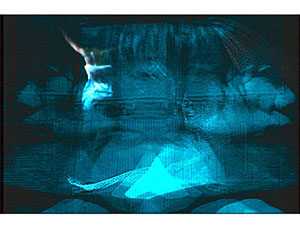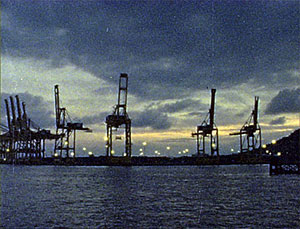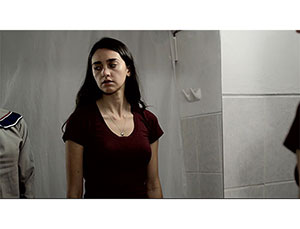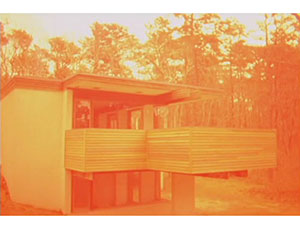HOME-MAKING (show 4) — TRT: 25.51
Definition: Managing of the place where one lives permanently, especially as a member of a family or household.
- SHE LEARNS TO LUNGE; (2009); Katya Yakubov; TRT: 8.30
How many shapes do the terrors of the mind take? Several transformations lead to an awakening between a modern house and a dark forest.Read more...

What as your creative process with this film?
Over several months, there was a slow accumulation of seemingly-disparate, time-based images, playing on loop in my head: the road, the slow pan of a living room, the repulsive flashes of a naked body. Eventually, writing the poem that would be heard as the voice-over and backbone of the film, I understood that these images were all part of a coherent whole, or perhaps, that all these images were birthed of a similar emotional nexus, and needed to be put in dialogue with each other, with the poem as the glue to hold them together. Once I began shooting and piecing the scenes together, there was a very clear and strong sense of narrative progression in the film. I almost think of the film as narrative now, rather than experimental or abstract.
What was your inspiration?
The fermentation of an emotional state sometimes leads to a feeling that a single idea can be distilled in the hidden weight of ordinary images. For me, seeing the final, missing scene was the culminating spark that allowed me to start actively making the film. This last image to make itself known was the image of the older woman. That evening, it became very clear to me what the film was about, and how to go about making it.
Where was it shot?
Because I was living in Peru as an ex-pat during the time I saw the image for the last, missing scene, I began to actively make the film there. About half of the film was shot and edited in Peru, and the other half back in New York. The scenes I captured in Peru were very informed by the environment there, and the film is better and richer for it. The foreignness and the Peruvian actress quietly add to and develop the idea behind the whole film, which is that of coming to terms with the uncanny image of seeing yourself from multiple vantage points, without making Peru the focus of the film. The film is really about anyone and anywhere, and the details that enrich it are only a refracted image of many possibilities.
Maybe you could comment on your spoken text: who are the “midget children.”
The ‘midget children’ is another reference of duality of innocence and evil, of something familiar and part of you (your child) and something uncanny and sinister (a distancing that comes from seeing the Other in the familiar; a midget—something with a negative connotation, something foreign).
What does it mean to “lunge” vs. another gesture or action?
There is something animal-like and bestial in the connotation of the word ‘lunge’ versus any other synonymous act. It implies, but doesn’t spell out, that it is an act of aggression yet impulse, of carnality yet self-preservation, of a kind beauty of ability, yet with a duality of strength resulting from terror.
How did you meet the actresses in your film & show are they.
I was already actively shooting the film in Peru, and looking for a tribal woman I could work with for one of the scenes, when sheer luck made encounter a temporary market set up in Lima, wherein several tribes from the Peruvian jungle had come to the capital to sell their crafts and handiwork. I had been familiar with Shipibo tradition very briefly, after traveling for a few days into this particular area of the jungle (San Francisco—a Shipibo town along the Ucayali River, which is a tributary of the Amazon). Seeing the market and the rare encounter with Shipibo culture prompted me to ask one of the women, who I thought would be perfect for the short role, to work with me. Unfortunately she canceled last minute, but her friend came, bringing her cousin and daughter with her, and it all worked out in the end. The scene with Graciela Valles Valera is incredibly short, yet a funny experience to shoot, as Graciela barely spoke a word of Spanish (the Shipibo speak their own tribal language), and so with my broken, high-school Spanish, I gave directions to her niece, who would then translate the instructions into Shipibo for her aunt.
There is only one other ‘actress’ aside myself in the film, and that is the old woman, who was played by my grandmother.
With this kind of material, I am not so interested in working with real actors, as I feel that the look and existing character of a person fit for that role already penetrates to the weight and meaning behind the images. My grandmother’s presence was exactly the quality that this particular scene needed. The whole scene took only a few minutes to shoot. I used myself as the younger girl character simply because it is easier to work with an actor that is already wherever you are, and who already is inside the idea you have for the film. So it was a matter of convenience, to know exactly what you need the expression on your face to be, without any verbal instruction.
Is there anything else you’d like to add:
The film also features a field recording of an healing-ayahuasca session preformed by a Shipbo shaman, Justina Serrano. The singing that Justina does with her son, Eligio Perez, is incredibly beautiful and haunting for me to listen to, and it was my absolute pleasure to see how well it fit as the main component to the soundtrack of this film.
- A PATTERN LANGUAGE; (2010); Tara Merenda Nelson; 16mm; TRT: 3.00
Charles Zehnde's Kugel Gips house in Wellfleet Massachusetts, and the Romanian B Minor scale.Read more...

What was the inspiration for this film?
In 2010, I was invited by filmmaker Ericka Beckman to participate in a residency through the Cape Cod Modern House Trust. I lived in the Gips Kugel house (the house in the film) for a week in March, 2010. Most of my time was spent at a beach about 5 miles away, where I was shooting the black and white sequences for HULL. But I wanted to pay tribute to that house, as it was truly an awe-inspiring structure, so serene and yet so formal. I began thinking about analogs between film and architecture, specifically how the process of creating a film compared to the process of designing and building a house. So I set out to “build” a film using primary elements: duration, repetition, interval, and image (color). Sound was later added but was not part of the original design.
This film was designed frame by frame on the page before it was shot. I was thinking about architecture and wanted to draft a sort of “blueprint” for a film that, once shot, would be a complete structure. While shooting, I manually exposed each frame for varying amounts of time, changing the color filter by hand as well. It took about 5 hours to shoot the entire 100 foot roll of 16mm film (roughly 4,000 frames).
Do you want to say anything about “A Pattern Language: Towns-Buildings-Construction” by Christopher Alexander?
During the residency we had dinner with the architect who restored the house (who is also the Director of the Cape Cod Modern House Trust), Peter McMahon. We talked about conceptual design and building practices, and he told me about the Alexander book, which proposes practical solutions to the existential problems through “good design”. Peter leant me his copy for the week and it made a tremendous impression on me. I still use the wisdom I found in that book in my daily life.
Why use music as the audio?
I don’t consider the score “music”, though it does correspond with a musical scale.
Sound was not part of the original design of the film, so when I decided to score it I wanted the sound to follow the picture, rather than to “narrate” some sort of emotion. I chose a scale with 5 notes, assigned each note a color and sustained the note for the duration of each color. No note is played for the frames that do not use a color filter. I didn’t know what the outcome would sound like but I was interested in the idea of using a single design for both sound and image.
I play each note on my Casio SK1, which is a 25 year-old toy keyboard.
Why the Romanian music key with these images? Is the Romanian key different form other music keys?
I have always been attracted to B minor. I don’t know why. It feels deeper than the other notes to me.
- MEMORAIS; (2012); Ana Rodríguez León; TRT: 7.01
Moments before than the Earth explodes, a woman remembers her relationship with a man.Read more...
Moments before than the Earth explodes, a woman remembers her relationship with a man at the beginning of the 21st century. But soon, the border between what really happen and what could had happen, vanishes. The woman would try to find some kind of truth before than, in the end, the world and her memories, get lost in the darkness of the night.

What inspired you to make MEMORAIS?
On one side, there was the aim to make a film about the nature of memory but in a science fiction context. That idea of joining an extreme future with a far away past felt like an attractive point of departure to me.
At that time, I was reading Poe’s tales, and there were two of them “The colloquy between Monos and Una”, and- specially- “The conversation of Eiros and Charmion”, which presented an apocalyptic scene, a world after the death of the Earth— these amazing tales were so inspiring to me.
On another side, I wanted to work with some images that I had recorded in a touristic ship called “Las golondrinas”, in Barcelona. I couldn’t had used these Super 8 images in my previous work Bell & Howell 2146 XL, and I really wanted to work with them, because these ship and its views are part of the memories of almost everybody who has born or lived for a long time in Barcelona. They were naturally tied with my own memories, so I could write more easily the character ones.
I tried to put the pieces all together, and create a story. What resulted, was MEMORAIS.
Your work has used memories as its base. Please tell us about your creative process.
The process of constructing our memories is actually amazing. I remember quite a long time ago, seeing Lynch’s Mulholland Drive and being sure that a particular image was in the film. Some time later, I saw the film again and the image I remembered was impossible to find. It seems that what I remembered was actually its own “composition” from some other images present in the film. That was a clear example to me of the uncertain nature of memory, that shows how we sometimes remember things that actually didn’t happen, or happened in a different way.
I began working with the images of Barcelona’s port and the idea of approaching the nature of memory through unsure facts and contradictions in the text, but it was during the editing process, where the question powerfully emerged: if the memories we construct can or can’t be considered less certain, or less valuable, than the events that we can catalogue as facts, if that catalogueing is actually possible, as Akira Kurosawa set out in Rashomon.
I worked on the text for a long time to bring to light these questions, and because I really enjoy working with words and the particular relation of rhythm and perception they establish with images. In the end, curiously, it was the absence of words – along with the use of color and sound- that became more significant in the short film, giving the audience the space to put their own ideas to it.
Time is not linear. A woman’s past, present and future spiral within simultaneously.
Read more...

DISPLACEMENT references “time”— can you comment on the chosen images in this piece?
DISPLACEMENT explores a state of feelings of a woman who suddenly realizes that her present is a multi faceted cross section of not only all those memories of things gone, but also all hopes and fears for her own future. She stands still in time as a vessel for the past and the future that flow through her experience of the present.
The chosen images show the things she experienced. They are repeated all over again though always in a different context. Music underlines these images further exploring the woman’s state of feelings; in specific moments we hear human voices, such as voices of a woman, man and a child.
Often you have used dancers in your works — please tell us about your creative process;or how you see space and time in film versus live dance work?
I am working as a filmmaker as well as a choreographer and I met many dancers before I decided to study film. One of them is Junko Sodeyama who dances in DISPLACEMENT. She has a kind of body awareness and concentration I needed for DISPLACEMENT.
I find film very exclusive as it makes detail choices what viewer should see at every instant.
This is quite opposite to a live dance work.













